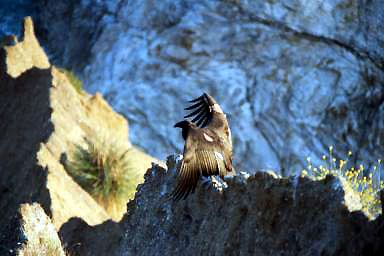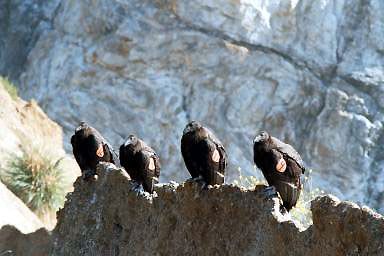 |
|
||||||||||||||||||
|
California condors, Gymnogyps californianus, are currently being reintroduced to the central coast by the Ventana Wildlife Society, which is a non-profit, 501(c)3, organization. The Society is dedicated to the preservation of native plants and animals through research, education, and restoration. By the efforts of the Ventana Wildlife Society, Condors are now seen throughout the mountains, coastal canyons and valleys of Big Sur. You can help in these efforts by donating time or money. Please contact the Ventana Wildlife Society directly if you would like to help. At the turn of the century, the California condor (Gymnogyps californianus) population began to plummet after decades of wanton shooting and poisoning. While habitat loss is a factor and limits the total population, the habitat that remains is still intact to sustain a population of condors. In 1987, the last wild condor was taken into captivity to join 26 others. A successful captive breeding and reintroduction program turned the tide. In 1998, the total population reached 150 birds, and 35 of those were in the wild. Given the success of bald eagle reintroduction, Ventana Wildlife Society was requested by the US Fish and Wildlife Service to join the California Condor Recovery Program in a ten-year first phase effort to bring the condor back from the brink of extinction. VWS is the first private non-profit in California to release condors. These majestic birds can be seen flying over the mountains and valleys of California's Central Coast. The goal of VWS is to restore condors to California. On March 4, 2000 six young condors were released in Big Sur bringing the number to 15. Click Here to download an indexed copy of Notes from the Field from November 1998 to February 2001 (PDF 128k) All California condors released by VWS are given identification tags placed on their wings so that field biologists can monitor their individual progress. The wing tags, also known as patagial tags, have different colors based on the date of their release: Blue - December 12, 1997; Yellow - January 30, 1999; Orange - March 4, 2000; and White - scheduled for release in March, 2001. Notes from the Field, December 2000 On December 18, 2000, Ventana Wildlife Society transported 3 condor chicks, 7 and 8 months old, from San Diego Wild Animal Park to Big Sur, California. The condors were flown up to Monterey Airport on a turbo prop aircraft donated by Monterey Airplane Company. Ventana Wildlife Society Biologists then drove the condors from the airport to the Big Sur release site. Since transfer the 3 young condors -- W19, W22, and W33 ("W"= white tag) have been acclimating to their new surroundings and new wild condor friends quite well. We allowed condor Or8 into the flight pen of the release facility for a week to provide mentoring to these young birds. All of the wild condors have shown a keen interest in the newcomers, nibbling beaks with them through the flight pen fence on many occasions. We plan to allow as many of the wild condors as possible into the flight pen for brief mentoring periods prior to the white tag release in late March. This will allow the white tags the opportunity to develop valuable social bonds with the wild flock prior to release.
Notes from the Field, November 2000 All California condors released by VWS are given identification tags placed on their wings so that field biologists can monitor their individual progress. The wing tags, also known as patagial tags, have different colors based on the date of their release: Blue - December 12, 1997; Yellow - January 30, 1999; and Orange - March 4, 2000.
Notes from the Field, October 2000
Notes from the Field, September 2000
Notes from the Field, August 2000 Temperatures soared into the triple digits this month. Condors Y92, B61, B64, B67, B70, and B71 spent a majority of the daylight hours on the wing, soaring along the ridge tops between Big Sur and the Sierra Madres in southern California. The rest of the Big Sur group concentrated activities on a short stretch of beach along the coast, the same beach where they discovered a sea lion carcass last month.
|
|
Notes from the Field, July 2000 The big news this month is that the orange-tagged condors found a sea lion carcass on a beach south of Big Sur. The carcass was located just north of a ravine that the orange-tags have been using as a source of fresh water for the past few months.
After several days of play, the condors finally got down to business and started eating the sea lion carcass . The feeding was tentative throughout the following days. This sea lion carcass, high in fat content, was the first sea mammal found by the orange tags, Y68 and Y90. Y94, who has fed on sea mammals before, also fed on this carcass. There has always been concern regarding the occurrence of lead in wild carcasses. Recent poisonings in the Arizona condor population have further escalated this concern. Thus, a tissue sample was taken from the sea lion carcass by Joe Burnett & Jessica Steffan and analyzed by Dr. Mike Murray, our project veterinarian. No lead or other toxic substances were found. The location of the sea lion has put the condors in relatively close proximity to coastal Highway 1. As a result, we have had several instances where passing motorists have seen and approached the birds, at times getting within 50 feet before field staff could intervene. One of the major obstacles in the recovery program is preventing the reintroduced condors from getting acclimated to the presence or approach of humans. If you do happen to spot the birds, please do not approach them. The best way to observe the condors, both for their and your safety, is from 100 feet or more and for short periods of time. The blue-tags have continued to fly back and forth between Big Sur and southwest Kern County. USFWS biologists observed B70 and B71 feeding with 16 condors from southern population in Santa Barbara County. Condor B71 spent the latter half of the month in Big Sur, a big change from May and June, where she spent most of her time in southern California. As of July 31, a fire is burning 15 miles south of the Big Sur condor release site in the southern Los Padres National Forest near Fort Hunter Liggett. The fire is 80% contained and moving in a southeasterly direction away from the release site. The expected control date for the fire is August 8, 2000. We don't expect this to be as threatening as the Sept/October '99 fire in which we had to evacuate 3 condors from the release site. See the Sept/October '99 Condor Field Notes for details of that evacuation.
Notes from the Field, June 2000 The condors are taking advantage of the long, hot days of summer to explore central and southern California. Summer conditions increase thermal activity and provide the "fuel" for condor flight. Columns of rising hot air, called thermals, act as invisible elevators for the birds. The condors spent a majority of the daylight hours this month soaring from thermal to thermal.
Notes from the Field, May 2000 The Big Sur condors reached two milestones this month. The blue- and yellow-tagged condors traveled further than ever before and orange-tagged condors Or99 and Or4 found a wild carcass earlier than any condor previously released in Big Sur.
On May 12, 2000 VWS condor biologist Marylise Lefevre discovered Or99 and Or4 feeding on a small, stillborn deer in the upper portion of Slide Canyon near Julia Pfeiffer Burns State Park. They located the carcass approximately 600 feet upslope from the Slide Canyon creek site the orange tags frequently visit to drink and bathe. Or99 and Or4 consumed the deer carcass the same day, leaving only the hide and skeletal remains. The other orange-tags (Or8, Or9 and Or12) did not discover this carcass, but continue to feed on supplemental carcasses at the release site and visit the slide canyon creek site to drink and bathe. Condor B70 followed the young orange-tags to Slide Canyon and stayed with them briefly before flying north to the Big Sur Valley. This was the first time any of the older condors had followed the orange-tags to this site. Click Here to download an indexed copy of Notes from the Field from November 1998 to Febrary 2001 (PDF 128k)
|
|
Notes from the Field, April 2000
Condors B61 and B71, last seen in Big Sur on April Fool's Day (April 1, 2000), were located by USFWS biologists in southern California near Frazier Mountain on April 5, 2000. B61 and B71 were observed flying and perching with as many as 10 USFWS condors at a time. This 150 + mile flight (one-way!!) marks the longest journey to date by the Big Sur condors. B61 and B71 returned to Big Sur on April 8 to rejoin the other blue, yellow, and orange tagged birds. On April 27 Ventana Wildlife Society biologists transferred Or200 to the USFWS release site in southern California. Or200 was recaptured in Big Sur shortly after release in early March due to behavioral problems. She was paired up with USFWS condor B1 to allow her more socialization time and both will be re-released in early May from the southern California site. She fed with condor B1 almost immediately after being placed in the release pen and only a couple of days later was observed nuzzling heads with her new penmate. Condor AC-8, re-released last month in southern California, has been slowly reestablishing her old ways. Her movements are being monitored via a satellite transmitter attached to her wing. The satellite location data has revealed that she has revisited parts of her original foraging range. USFWS biologists have not observed the younger condors follow her to these locations, but anticipate it will happen within the next couple of months. AC-8 can be identified in the field by a blue tag with a white number 12. The best bet for observing condors in Big Sur is at Pfeiffer Big Sur State Park. Good Luck and don't forget your binoculars!! Click Here to download an indexed copy of Notes from the Field from November 1998 to February 2001 (PDF 128k)
Notes from the Field, March 2000
Notes from the Field, February 2000
Notes from the Field, January 2000
Click Here to view Condor Field Notes for 2003 For More Information Contact: Notes from the Field supplied by the Ventana Wildlife Society. Condor Facts Range: In 1800, from Baja California to British Columbia; reintroduced populations in central and southern California and in northern ArizonaFood: Carcasses of large animals such as deer, cattle and sea mammals. Condor watching locations:
Click Here to view the Field Notes for 1998, & 1999 Click Here to download an indexed copy of Notes from the Field from November 1998 to February 2001 (PDF 128k) |
|
Click here to purchase books about Big Sur |
Big Sur Chamber of Commerce - http://www.bigsurcalifornia.org (831) 667-2100




